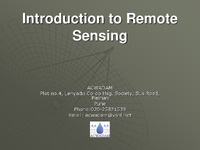Items
Tag
Geospatial Analysis
-
 Introduction to remote sensing Remote sensing is a technique that gathers information about objects or areas from a distance using sensors on platforms like satellites, airplanes, or balloons, without direct contact. It aids in monitoring various elements such as forests, water resources, agriculture, and urban areas, as well as dynamic phenomena like natural disasters and weather patterns. Different sensors, including cameras and thermal scanners, operate at varying distances and resolutions. Remote sensing utilizes electromagnetic energy, which can be natural or artificial, and works through atmospheric windows that allow specific wavelengths to penetrate the atmosphere. Its applications span multiple fields including geology, urban planning, agriculture, and disaster management.
Introduction to remote sensing Remote sensing is a technique that gathers information about objects or areas from a distance using sensors on platforms like satellites, airplanes, or balloons, without direct contact. It aids in monitoring various elements such as forests, water resources, agriculture, and urban areas, as well as dynamic phenomena like natural disasters and weather patterns. Different sensors, including cameras and thermal scanners, operate at varying distances and resolutions. Remote sensing utilizes electromagnetic energy, which can be natural or artificial, and works through atmospheric windows that allow specific wavelengths to penetrate the atmosphere. Its applications span multiple fields including geology, urban planning, agriculture, and disaster management.
